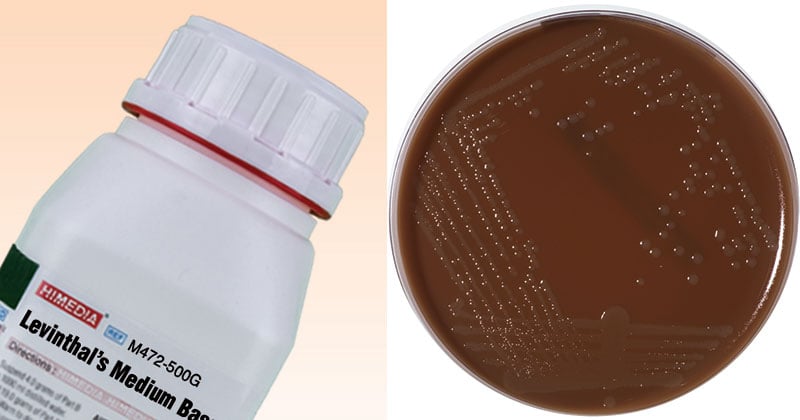Levinthal’s Medium is used for the cultivation of Haemophilus species. The genus Haemophilus includes a number of species that cause a wide variety of infections but share a common morphology and a requirement for blood-derived factors during growth that has given the genus its name. The Haemophilus genus represents a large group of gram-negative rods that grow on agar-containing blood. The blood provides two factors, which many Haemophilus species require for growth: factor-X and factor-V.

Interesting Science Videos
Composition of Levinthal’s Medium
| Ingredients | Gms/liter |
| Peptic digest of animal tissue | 10.000 |
| Beef extract | 10.000 |
| Sodium chloride | 5.000 |
| Bacitracin | 0.300 |
| Agar | 20.000 |
Final pH (at 25°C): 7.6±0.2
Principle of Levinthal’s Medium
- Whole blood of rabbit or human blood contains two important factors viz factor-X and factor-V, which are necessary for the growth of type species of influenzae.
- Factor-X is a heat stable substance, the hemin associated with hemoglobin, whereas factor-V is a heat labile coenzyme Nicotinamide Adenine Dinucleotide (NAD).
- Other nutrients such as nitrogen compounds are supplied by a peptic digest of animal tissue and beef extract incorporated in the medium.
- Sodium chloride helps to maintain the osmotic balance of the medium.
- The bacitracin added inhibits normal flora, which enhances the recovery of Haemophilus species.
- Pathogenic Haemophilus species may be presumptively identified by determining in vitro growth requirements for X and V factors and by hemolytic reactions on the agar.
Preparation of Levinthal’s Medium
- Suspend 45 grams in 1000 ml distilled water.
- Heat to boiling to dissolve the medium completely.
- Dispense in 100 ml amounts and sterilize by autoclaving at 15 lbs pressure (121°C) for 15 minutes.
- Cool to 50°C and add 5 ml sterile rabbit or human blood to 100 ml medium.
- Heat the mixture in boiling water bath.
- Allow the deposits to settle and dispense clear supernatant.
- Pour into sterile petriplates.
Result Interpretation on Levinthal’s Medium
| Organisms | Growth |
| Haemophilus influenza | Luxuriant growth; capsulated strains show translucent colonies with distinctive iridescence; non-capsulated strains are transparent, bluish, and non-iridescent. |
| Staphylococcus aureus | Luxuriant growth |
| Streptococcus pyogenes | Luxuriant growth |
Uses of Levinthal’s Medium
- Levinthal’s Medium Base with the addition of blood is used for cultivation of Haemophilus species.
- It can be used for cultivating a variety of fastidious organisms.
Limitation of Levinthal’s Medium
- It is recommended that biochemical, immunological, molecular, or mass spectrometry testing be performed on colonies from pure culture for complete identification.
References
- http://www.himedialabs.com/TD/M472.pdf
- https://www.ncbi.nlm.nih.gov/pubmed/8508821
- https://apps.szu.cz/cnctc/media/MEDIUM%20FORMULATIONS.pdf
- http://www.himedialabs.com/intl/en/products/Microbiology/Dehydrated-Culture-Media-Diagnostic-Animal-based-Media-Bacterial/Levinthals-Medium-Base-M472
- https://www.thomassci.com/Laboratory-Supplies/Microbiological-Media/_/Levinthals-Medium-Base
- https://books.google.com.np/books?id=MXMazr0LRDsC&pg=PA334&lpg=PA334&dq=levinthal+medium+hardy&source=bl&ots=0vMefp0BuW&sig=ACfU3U2QEEbA9EpScn5Xou8GEwH5uDTbog&hl=en&sa=X&ved=2ahUKEwj245Tj1aLhAhVOX30KHWBEBoEQ6AEwBHoECAgQAQ#v=onepage&q&f=false
- https://www.jcdr.net/article_fulltext.asp?id=2065
- https://books.google.com.np/books?id=GS_FDAAAQBAJ&pg=PA257&lpg=PA257&dq=levinthal+agar+with+bacitracin&source=bl&ots=oOqVi6HMcO&sig=ACfU3U0VHaXc6eGjdzksCNgp8Qa5GyVD-w&hl=en&sa=X&ved=2ahUKEwiTn5KLyafhAhWEto8KHdupDFIQ6AEwB3oECAkQAQ#v=onepage&q=levinthal%20agar%20with%20bacitracin&f=false
- https://jcp.bmj.com/content/jclinpath/13/6/519.full.pdf
